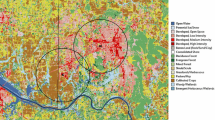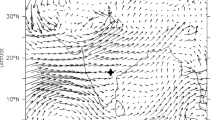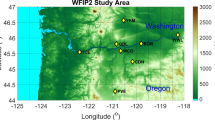Abstract
The planetary boundary-layer (PBL) height is determined with high temporal and altitude resolution from lidar backscatter profiles. Then, the frequencies of daytime thermal updrafts and downdrafts and of nighttime gravity waves are obtained applying a fast Fourier transform on the temporal fluctuation of the PBL height. The principal frequency components of each spectrum are related to the dominant processes occurring at the daytime and nighttime PBL top. Two groups of cases are selected for the study: one group combines daytime cases, measured in weak horizontal wind conditions and dominated by convection. The cases show higher updraft and downdraft frequencies for the shallow, convective boundary layer and lower frequencies for a deep PBL. For cases characterized by strong horizontal winds, the frequencies directly depend on the wind speed. The temporal variation of the PBL height is determined also in the likely presence of lee waves. For nighttime cases, the main frequency components in the spectra do not show a real correlation with the nocturnal PBL height. Altitude fluctuations of the top of the nocturnal boundary layer are observed even though the boundary layer is statically stable. These oscillations are associated with the wind shear effect and with buoyancy waves at the PBL top.
Similar content being viewed by others
Abbreviations
- PBL:
-
Planetary boundary layer
- CBL:
-
Convective boundary layer
- EARLINET:
-
European Aerosol Research Lidar Network
- EC:
-
European Commission
- EZ:
-
Entrainment zone
- FFT:
-
Fast Fourier transform
- FOV:
-
Field of View
- GS:
-
Gradient signal
- KH:
-
Kelvin–Helmholtz
- NBL:
-
Nocturnal boundary layer
- RCS:
-
Range-corrected signal
- SNR:
-
Signal-to-noise ratio
- UTC:
-
Universal Coordinated Time
- Var:
-
Variance
References
Alpers W, Stilke G (1996) Observation of nonlinear wave disturbance in the marine atmosphere by the synthetic aperture radar aboard the ERS-1 satellite. J Geophys Res 101(C3): 6513–6525
Beyrich F, Gryning SE (1997) Estimation of the entrainment zone depth in a shallow convective boundary layer from sodar data. J Appl Meteorol 37: 255–268
Blumen W (ed) (1990) Atmospheric processes over complex terrain. American Meteorological Society, Boston, 394 pp
Böckmann C, Wandinger U, Ansmann A, Bösenberg J et al (2004) Aerosol lidar intercomparison in the framework of EARLINET: Part II-aerosol backscatter algorithms. Appl Opt 43:977–989
Bösenberg J, Linné H (2002) Laser remote sensing of the planetary boundary layer. Meteorol Z 11: 233–240
Bösenberg J, Matthias V (2003) EARLINET: European Aerosol Research Lidar Network to establish an aerosol climatology. Final report for the period of February 2000 to February 2003 (contract EVRI-CTI999-40003), 62 pp
Caccia JL, Benech B, Klaus V (1997) Space–time description of nonstationary trapped lee waves using ST radars, aircraft and constant volume balloons during the PYREX experiment. J Atmos Sci 54: 1821–1833
Caughey SJ, Palmer SG (1979) Some aspects of turbulence structure through the depth of the convective boundary layer. Q J Roy Meteorol Soc 105: 811–827
De Wekker SFJ, Kossmann M, Fielder F (1997) Observations Of daytime mixed layer heights over mountainous terrain during the TRACT field campaign. In: Proceedings of the 12th AMS symposium on boundary layers and turbulence, Vancouver, BC, Canada. American Meteorological Society, Boston, pp 498–499
Deardorff JW (1969) Numerical study of heat transport by internal gravity waves above a growing unstable layer. Phys Fluids Suppl II 12: 184–194
Doyle JD, Smith RB (2003) Mountain waves over the Hohe Tauern: influence of upstream diabatic effects. Q J Roy Meteorol Soc 129: 799–824
Flamant C, Pelon J, Flamant PH, Durand P (1997) Lidar determination of the entrainment zone thikness at the top of the unstable marine atmospheric boundary layer. Boundary-Layer Meteorol 83: 247–284
Garratt JR (1992) The atmospheric boundary layer. Cambridge University Press, UK, p 316 pp
Greenhut GK, Khalsa SJS (1987) Convective elements in the marine atmospheric boundary layer. Part I: Conditional sampling statistics. J Appl Meteorol 26: 813–823
Hägeli P (1998) Evaluation of a new technique for extracting mixed layer depth and entrainment zone thickness from lidar backscatter profiles. Diploma thesis at the Dept. of Geography of the Swiss Federal Institute of Technology ETHZ
Hägeli P, Steyn DG, Strawbridge KB (2000) Spatial and temporal variability of mixed-layer depth and entrainment zone thickness. Boundary-Layer Meteorol 97: 47–71
Hennemuth B, Lammert A (2006) Determination of the atmospheric boundary layer height from radiosonde and lidar backscatter. Boundary-Layer Meteorol 120: 181–200
Kunz GJ, De Leeue G, Becker E, O’Dowd CD (2002) Lidar observations of atmospheric boundary layer stucture and sea spray aerosol plumes generation and transport at Mace Head, Ireland. (PARFORCE experiment). J Geophys Res 107(D19):8106. doi:10.1029/2001JD001240
Lammert A, Bösenberg J (2006) Determination of the convective boundary layer height with laser remote sensing. Boundary-Layer Meteorol 119: 158–170
Lane TP, Reeder MJ, Morton BR, Clark TL (2000) Observations and numerical modelling of mountain waves over the Southern Alps of New Zealand. Q J R Meteorol Soc 126: 2765–2788
Martucci G, Matthey R, Mitev V, Richner H (2007) Comparison between backscatter lidar and radiosonde measurements of the diurnal and nocturnal stratification in the lower troposphere. J Atmos Ocean Technol 24: 1231–1244
McIlveen R (1992) Fundamentals of weather and climate. Chapman & Hall, UK, p 497 pp
Menut L, Flamant C, Pelon J, Flamant PH (1999) Urban boundary layer height determination from lidar measurements over the Paris area. Appl Opt 38: 945–954
Nance L, Durran D (1997) A modeling study of nonstationary trapped mountain lee waves. Part I: Mean flow variability. J Atmos Sci 54: 2275–2291
Nance L, Durran D (1998) A modeling study of nonstationary trapped mountain lee waves. Part II: Nonlinearity. J Atmos Sci 55: 1429–1445
Neu U, Künzle T, Wanner H (1994) On the relation between ozone storage in the residual layer and the daily variation in near-surface ozone concentration—a case study. Boundary-Layer Meteorol 69: 221–247
Ralph FM, Neiman PJ, Keller TL, Levinson D, Fedor L (1997) Observations, simulations, and analysis of nonstationary trapped lee waves. J Atmos Sci 54: 1308–1333
Rampanelli G, Zardi D (2004) A method to determine the capping inversion of the convective boundary layer. J Appl Meteorol 43: 925–933
Rayment R, Readings CJ (1974) A case study of the structure and energetics of an inversion. Q J Roy Meteorol Soc 100: 221–233
Scorer RS (1957) Experiments on convection of isolated masses of buoyant fluid. J Fluid Mech 2: 583–594
Sicard M, Perez C, Rocadenbosch F, Baldasano J, Garcıa-Vizcaino D (2006) Mixed-layer depth determination in the Barcelona Coastal Area from regular lidar measurements: methods, results and limitations. Boundary-Layer Meteorol 119:135–157
Siebert P, Beyrich F, Gryning SE, Joffre S, Rasmussen A, Tercier Ph (2001) Review and intercomparison of operational methods for the determination of the mixing height. Atmos Environ 34: 1001–1027
Steyn DG, Baldi M, Hoff RM (1998) A new technique to derive mixed layer depth and entrainment zone thickness from lidar profiles. In: Abstracts of papers of the 19th international laser radar conference (ILRC), Annapolis, USA, 6–10 July 1998, pp 461–464
Steyn DG, Baldi M, Hoff RM (1999) The detection of mixed layer depth and entrainment zone thickness from lidar backscatter profiles. J Atmos Ocean Technol 16: 953–959
Stull RB (1973) Inversion rise model based on penetrative convection. J Atmos Sci 30: 1092–1099
Stull RB (1988) An introduction to boundary layer meteorology. Kluwer Academic Publishers, Dordrecht, 666 pp
Weitkamp C (2005) Lidar: range-resolved optical remote sensing of the atmosphere. Springer series of optical sciences, vol 102, 460 pp
Wiegner M, Emeis S, Freudenthaler V, Heese B, Junkermann W, Münkel Ch, Schäfer K, Seefeldner M, Vogt S (2006) Mixing layer height over Munich, Germany: variability and comparisons of different methodologies. J Geophys Res 111:D13201. doi:10.1029JD006593
Young GS (1988a) Convection in the atmospheric boundary layer. Earth Sci Rev 25: 179–198
Young GS (1988b) Turbulence structure of the convective boundary layer I: variability of normalized turbulence statistics. J Atmos Sci 45: 719–726
Young GS (1988c) Turbulence structure of the convective boundary layer II: PHOENIX 78 aircraft observations of thermals and their environment. J Atmos Sci 45: 727–735
Zampieri M, Malguzzi P, Buzzi A (2005) Sensitivity of quantitative precipitation forecast to boundary layer parameterization: a flash flood case study in the Western Mediterranean. Nat Hazards Earth Syst Sci 5: 603–612
Author information
Authors and Affiliations
Corresponding author
Additional information
Giovanni Martucci and Renaud Matthey—formerly at Observatory of Neuchâtel, Rue de l’Observatoire 58, CH-2002, Neuchâtel, Switzerland.
Rights and permissions
About this article
Cite this article
Martucci, G., Matthey, R., Mitev, V. et al. Frequency of Boundary-Layer-Top Fluctuations in Convective and Stable Conditions Using Laser Remote Sensing. Boundary-Layer Meteorol 135, 313–331 (2010). https://doi.org/10.1007/s10546-010-9474-3
Received:
Accepted:
Published:
Issue Date:
DOI: https://doi.org/10.1007/s10546-010-9474-3




